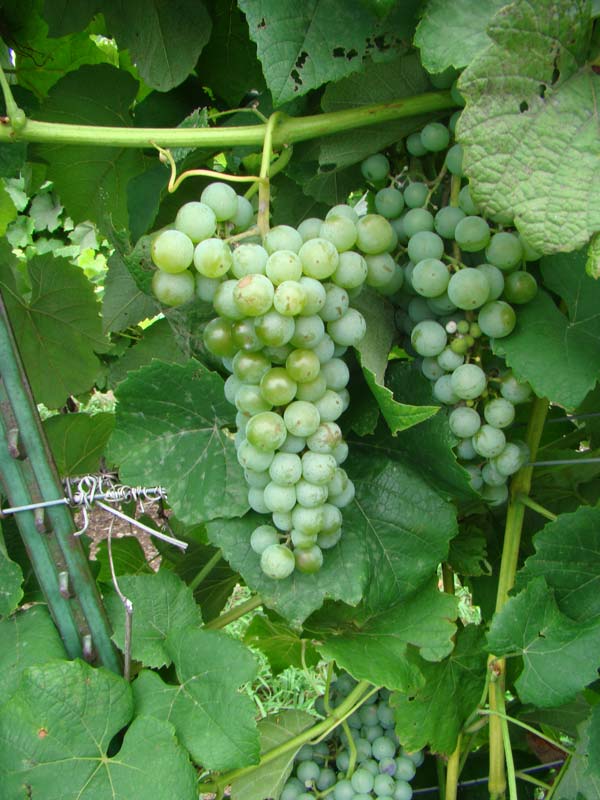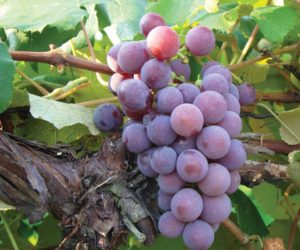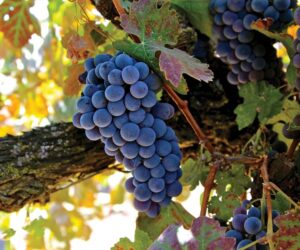
Spring has sprung, fall has fell, summer is here, and, well, it’s hotter than . . . well you get the picture. It’s called farming and in the world of grapes, we left out one season: Winter. As I write this article it’s spring here in California, but I am sitting in my office, high in the Sierra Nevada mountains watching it snow and really developing a kinship to my colleagues across the country that are challenged with these conditions on an annual basis.
That is not to say that in California we do not have our share of viticultural challenges, but I have to say that these conditions make the grape grower a hardy person . . . just like the grape varieties they are growing. Some grapes are better than others for certain climates and it always seems like there is a new and better version on the horizon. A relatively old variety, by modern breeding standards, that is well known in the interspecific hybrid community gets our attention in this issue.
Cayuga’s Origins
The original cross that created Cayuga White (New York 33403, G.W. 3) was carried out in 1945, at the New York State Agricultural Experiment Station in Geneva, New York. The breeders were John Einset and W.B. Robinson. The two worked with a well-known grape breed pedigree Seyve-Villard 5-276, from the better-known Seyval line, and a lesser-known grape named Schuyler. Seyval has a genetic background consisting of several vinifera varieties, V. labrusca, as well as several non-labrusca American species. Schuyler, which was formally introduced two years later in 1947, is a cross between Zinfandel and Ontario.
The latter being an early white American grape cross of Winchell and Moore’s Diamond. The fruit was first described in 1952 and was selected for further trial, working its way to what is referred in the breeding world as a “25-vine trial” in 1964. The trial took place over the next eight years and the variety was formally released commercially in 1972. In the original paper, published that same year, the breeders described Cayuga White as a grape with a “complex origin and appears to be a blend of some of the most desirable characters of its progenitors.” At the time it was also classified as one of the most productive and disease-resistant varieties grown in New York.
In The Vineyard
The vine is late-budding, vigorous, high-yielding, and rated as medium hardy (cold tolerance rating), depending on where it is grown. The late budding helps protect it from spring frosts, which is good because the secondary buds are not productive. Select your location carefully. Cold hardiness, in the scientific realm, refers to the grapevine tissue’s ability to survive cold temperatures during autumn and winter. It is defined as the temperature that causes mortality of 50% of the primary buds in mid-winter, or LT50 (LT stands for lethal temperature). The LT50 for Cayuga is -10 to -15 °F (-23 to -26 °C). A 50% bud kill can be catastrophic, but vines do gradually develop tolerance to low temperatures to reach a maximum tolerance level that is dependent on the variety, the environment, and cultural practices. A good review of cold hardiness and mitigation efforts can be found here: https://aggie-horticulture.tamu.edu/vitwine/2018/05/10/cold-hardiness/). Check with your local university extension programs for more specific information for your area.
The late budding helps protect it from spring frosts, which is good because the secondary buds are not productive.
Cayuga White is reported to be moderately susceptible to crown gall and downy mildew; and slightly susceptible to black rot, Botrytis bunch rot, and powdery mildew. It is highly susceptible to anthracnose and slightly susceptible to Phomopsis cane and leaf spot. This cultivar is listed as having low sensitivity to sulfur but somewhat sensitive to injury from copper when applied under cool, slow-drying conditions. It is somewhat susceptible to injuries from 2,4-D and dicamba.
Where is Cayuga White grown? Being a firm believer of growing the right variety in the right place, you will find it fairly popular across the eastern United States. In New York you will find it planted on the slopes above Seneca and its namesake Cayuga Lakes in the Finger Lakes region. Vermont, Ohio, Pennsylvania, Connecticut, Indiana, Massachusetts, Oregon, and Nebraska report Cayuga as being grown within their borders. It is found elsewhere in the Midwest, but its cold hardiness limits its growing possibilities and there are several other great cold-hardy varieties coming out of the University of Minnesota to replace it that work better in those climates. The 2011 Wisconsin Viticultural survey reports that while not a major variety there, there was an active phase of removing some Cayuga vineyards.
Viticulturally, its high yields need to be managed so the vine ripens optimally for your region. The clusters are medium to large and medium compact. Average cluster weight is about a half a pound (230 g). One report from a trial in Oregon listed a yield of 13 tons per acre. The author’s conclusion suggests undertaking a “green-harvest” to reduce the crop load to help distribute the vine’s energy amongst fewer clusters. While winemakers think the lowest yields produce the best grapes, the grape grower deserves some respect in that they need to make some money. Again, your local extension specialists can assist with this practice. Green harvest is practiced in all winemaking regions of the world when the growing seasons can be cut short by an early fall.
In the Winery
The grape is extremely versatile in that wines can be made dry, semi-sweet, and even sparkling. The drier white versions even blend well into oak. The general classification of its varietal wines is of having medium body and good balance. But to make wines from Cayuga, you need to look at your harvest conditions. Harvest levels of 17–19 °Brix are well regarded for producing dry wines with some fruity character and possibly higher acidity. The acidity can be balanced with the back addition of sugar in the form of grape concentrate or juice, which can enhance not only the sweetness but also the wine’s fruit character.
Cayuga White grapes fermented dry can be made into sparkling wine and over time take on those yeasty, nutty characteristics lovers of bubbles appreciate when properly aged on the lees. But when left on the vine too long, Cayuga, like many of its relatives, can take on some of the strong hybrid aromas as a result of its labrusca heritage. In another report, it was listed as “hanging well” two to four weeks after normal harvest numbers of 17–19 °Brix. So it should do well as a later harvest wine but be aware of the appearance of the American “foxy” characteristic.
It is a variety that pairs well with food. There is a bevy of possible dishes to pair with based on the residual sugar, acidity structure, and overall fruitiness of the wine you have on hand. These wines are typically not age worthy (unless you’re aging on the lees) so taking advantage of its rich pairing possibilities when young is paramount. Going to a clambake? Take a bottle or two of dry Cayuga. In general, most seafood works well with this varietal. My preference is for higher acidity wines to accompany fish similar to the traditions of Muscadet and the fare of the lower Loire River. While most Cayuga is made in these dry styles, the sweeter versions match well with glazed ham or baked chicken. Finish the evening with a sparkling version and your cheese plate!
The snow is abating somewhat, but I still feel the connection with my colleagues. I heard reports of cold weather in the Ohio Valley and Pennsylvania. My placement in the cold of this weekend was strictly my choice. The place you choose to grow grapes may not be an option. But you are now provided with a bevy of information regarding this “old” hybrid variety to help determine what’s right for you. The popularity and relative longevity of Cayuga makes it an optimal variety, as there is plenty of advice from folks that have worked with this grape for decades. But stay on top of the latest research and information and do what you do best. Make the highest quality wine you can! Because if you are not going to make good wine, why bother?
Cayuga White Recipe
Yield 5 gallons (19 L)
Ingredients
- 100 lbs. (45 kg) Cayuga White fruit or approximately 6 gallons (23 L) commercially available juice
- Distilled water
- 10% potassium metabisulfite (KMBS) solution (Weigh 10 grams of KMBS, dissolve into about 75 milliliters (mL) of distilled water. When completely dissolved, make up to 100 mL total with distilled water.)
- 5 g Lallemand QA23 yeast
- 10 g Fermaid K (or equivalent yeast nutrient)
- 5 g Diammonium phosphate (DAP)
- Malolactic fermentation starter culture (CHR Hansen or equivalent)
Equipment
- 5-gallon (19-L) carboy
- 6-gallon (23-L) carboy
- 6-gallon (23-L) plastic bucket
- Airlock/stopper
- Racking hoses
- Equipment cleaning and sanitizing agents (Bio-Clean, Bio-San)
- Inert gas (nitrogen, argon, or carbon dioxide will do)
- Refrigerator (~45 °F/7 °C) to cold settle the juice. Remove the shelves so that the bucket will fit
- Ability to maintain a fermentation temperature of 55 °F (13 °C)
- Thermometer capable of measuring between 40–110 °F (4–43 °C)
- Pipettes with the ability to add in increments of 1 mL
Step by Step
- Crush and press the grapes. Do not delay between crushing and pressing. Move the must directly to the press and press lightly to avoid extended contact with the skins and seeds.
- Transfer the juice to a 6-gallon (23-L) bucket. During the transfer, add 16 milliliters of 10% KMBS solution. (This addition is the equivalent of 40 ppm SO2.) Move the juice to the refrigerator.
- Let the juice settle at least overnight. Layer the headspace with inert gas and keep covered.
- When sufficiently settled, rack the juice off of the solids into the 6-gallon (23-L) carboy. Add Fermaid K.
- Prepare yeast. Heat about 50 mL distilled water to 104 °F (40 °C). Do not exceed this temperature as you will kill the yeast. Sprinkle the yeast on the surface of the heated water and gently mix so that no clumps exist. Let sit for 15 minutes undisturbed. Measure the temperature of the yeast suspension. Measure the temperature of the juice. You do not want to add the yeast to your cool juice if the temperature difference exceeds 15 °F (8.3 °C). Acclimate your yeast by taking about 10 mL of the cold juice and adding it to the yeast suspension. Wait 15 minutes and measure the temperature again. Do this until you are within the specified temperature range. When the yeast is ready, add it to the carboy.
- Initiate the fermentation at room temperature ~(65–68 °F/18–20 °C) and once fermentation is noticed, (~24 hours) move to a location where the temperature can be maintained at 55 °F (13 °C). If your fridge is too cold (colder than 55 °F/13 °C), consider placing the carboy in a water bath and add ice as needed while monitoring the temperature.
- Two days after fermentation starts, dissolve the DAP in as little distilled water required to completely dissolve into solution (usually ~20 mL). Add directly to the carboy.
- Normally you would monitor the progress of the fermentation by measuring Brix. One of the biggest problems with making white wine at home is maintaining a clean fermentation. Entering the carboy to measure the sugar is a prime way to infect the fermentation with undesirable microbes. So at this point, the presence of noticeable fermentation is good enough. Sanitize anything in contact with the juice.
- Leave alone until bubbles in the airlock are ticking at about one bubble per minute.
- After about two to three weeks it is time to start measuring the sugar. Sanitize your thief; remove just enough liquid to use for your hydrometer. Record your results. If the Brix is greater than 7 °B wait another week before measuring. If the Brix is less than 7 °B; begin measuring every other day. Continue to measure the Brix every other day until you have two readings in a row that are negative and about the same. This should be -1.5 °Brix or lower for a dry wine.
- Taste the wine. If the wine is dry, rack to the five-gallon (19-L) carboy and control for headspace. Consider adding your malolactic bacteria if the acidity is very high. Depending on acidity levels, to either prevent MLF starting, stall MLF from going to completion, or once MLF is complete add 3 mL 10% KMBS solution per gallon (3.8 L) to begin stabilizing the wine. Lower the temperature to ~45 °F (7 °C).
- Let the lees settle for about two weeks and stir them up. Repeat this every two weeks for eight weeks. This will be a total of four stirs. This is called the bâtonnage. You’re doing this to enhance the mouthfeel. This process is known as sur lie aging.
- After the second stir, check the SO2 and adjust to 30–35 ppm free SO2 (see note later).
- Let the lees settle after the final stir. At this point, the wine is going to be crystal clear or a little cloudy. If the wine is crystal clear, then that is great! If the wine is cloudy, then presumably, if you have kept up with the SO2 additions and adjustments, temperature control, kept a sanitary environment, and there are no visible signs of a refermentation, then this is most likely a protein haze. If you choose to, you can fine with bentonite to clarify.
- While aging, test for SO2 and keep maintained at 30–35 ppm. Titratable acidity target is about 6.5 g/L. The pH target is around 3.4–3.5, but rely more on the TA as that is going to contribute to mouthfeel. You do not want an overly acidic (by mouth) wine.
- Once the wine is cleared it is time to move it to the bottle. This would be about six months after the onset of fermentation. If all has gone well to this point, given the quantity made, it can probably be bottled without filtration. Your losses during filtration could be significant. That said, maintain sanitary conditions while bottling and you should have a fine example of a clean, creamy, dry Cayuga White wine. Enjoy!






